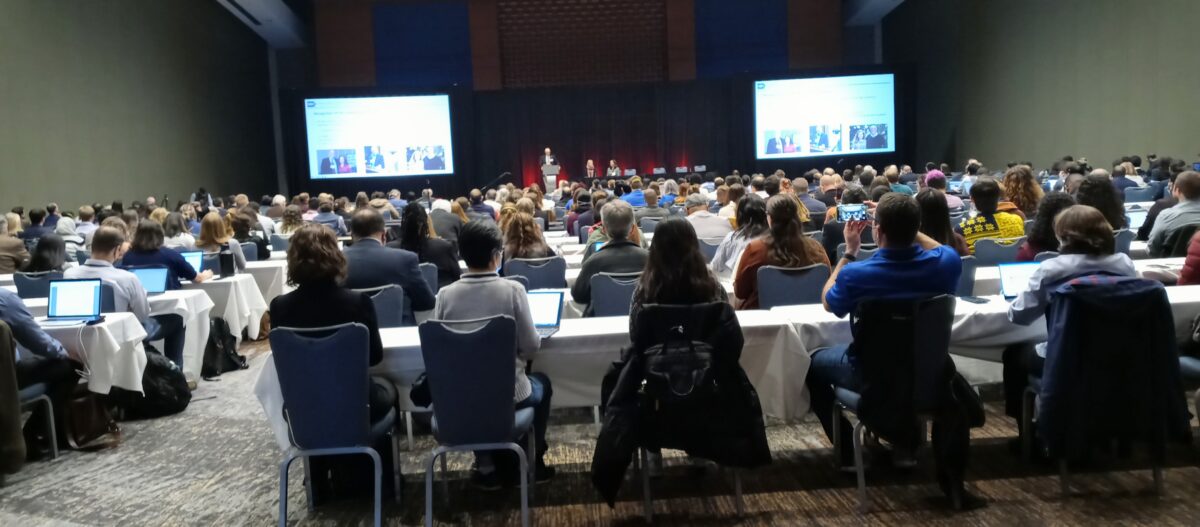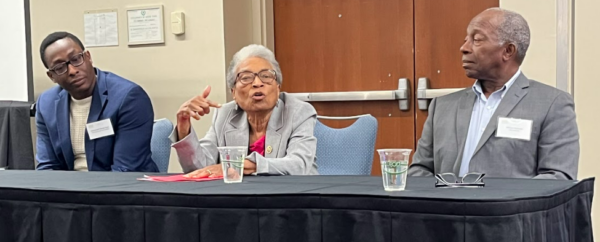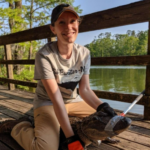April 2023 Newsletter
Sign up to receive our Center Newsletter!
HOW DID THE SUPERFUND START AND WHAT IS OUR MISSION?

In 2016, NC State and EPA scientists reported the presence of high concentrations of perfluorinated compounds in North Carolina’s Cape Fear River and its watershed, and in the drinking water supply of more than 200,000 North Carolinians living downstream of the Chemours chemical manufacturing plant. Our Center aims to determine the toxicity and bioaccumulation potential of these chemicals and to devise methods of prevention and remediation that will restore the quality of North Carolina’s water.
The mission of this cross-disciplinary Center is to advance research, technology development, training and community engagement about exposure to a class of ubiquitous environmental compounds known as per- and polyfluoroalkyl substances (PFAS). The long-term objectives are to assess PFAS 1) exposure in impacted areas, 2) toxicity and underlying mechanisms of thyroid and immune function, 3) bioaccumulation potential, and 4) remediation.
STAFF INTERVIEWS AND UPDATES
Meet Some of Our Staff
Emily Griffith is the new DMAC Core Interim Director. Emily is with the NC State Department of Statistics and will be directing DMAC Core.

My position at NC State is an interesting (and fairly unique) one because the bulk of my work is truly applied and collaborative– I spend much of my time helping other researchers collect data in an organized way, use their data effectively, apply up-to-date statistical techniques, and make sense of their findings. My own research agenda focuses on how to provide this kind of support in a meaningful and effective way and how to train the next generation of statisticians and data scientists to communicate effectively and work collaboratively.
I am somewhat new to PFAS. I’ve been involved with the Center for Human Health and the Environment as a consulting statistician since last summer and have really enjoyed seeing the immediate impact of the work. I am interested in a wide variety of areas of application and enjoy having that variety in my work, but seeing PFAS in the news after I started working with the folks at CHHE was really exciting.
When I was asked to consider being the Interim Director of DMAC, I was thrilled. I love knowing that I can help work on something so impactful– improving the lives of people, animals, and helping the environment. I also truly enjoy seeing such brilliant scientists work on these projects.
A current project that I’m working on, outside of PFAS but related to DMAC, is a workshop on how to structure sustainable statistical and data science consulting models in higher education institutions. I am co-organizing this workshop with the NC State Libraries through the Data Science Academy, and we are funded by the Alfred P. Sloan Foundation. Understanding the landscape of data-based research enablement at NC State, and learning how those programs are organized at other universities, will help me navigate the variety of needs that DMAC is addressing.
Welcome to the Superfund Emily!
Katlyn (Katy) May is the Director of the Community Engagement Core

I lead the Center’s Community Engagement Core (CEC), working closely with our Research Translation leader, community partners, Center members, and trainees. The CEC has three main goals: work directly with people in communities impacted by PFAS contamination, facilitate back-and-forth communication between Center researchers and stakeholders, and build capacity of Center researchers and their trainees to communicate and engage with non-academic audiences around PFAS. Since 2017, many community leaders and nonprofits have been on the ground, addressing PFAS contamination throughout the Cape Fear River Basin. The CEC strives to support and complement this work, not take over or lead it. Over the last few years, the CEC has helped our partners conduct community-based water sampling, engage with state lawmakers, provide educational resources for distribution in communities (think: infographics, fact sheets), among many other collaborative initiatives.
Our Center members are some of the national and international leaders in their respective areas of research, so it’s critical that the work they’re doing is made available in ways that are useful for people interested in and impacted by PFAS. What PFAS are in people’s bodies? How do PFAS impact our ecosystems? How can we get PFAS out of our water? These are all things that communities throughout North Carolina want to know, and that our Center was designed to help answer. The CEC works with researchers and community partners to create materials, videos, social media content, and community events so that these findings do not just live in academic journals. Our community partners are experts, too, so the CEC ensures that they have a direct line to Center leadership and researchers. Our partners have invaluable local knowledge and ask questions that help shape how we think about our Center’s research. For example, our partners know where there are neighborhoods that use private well water that have not been tested by DEQ, or what kinds of fish should be tested for PFAS because they’re the ones people actually eat, or the feasibility of using one type of in-home filter over another, or how to talk about health study results in a way that’s most meaningful for participants. The CEC works to get Center research out, but works just as hard to get community-based knowledge in.
Lastly, the CEC wants to help our Center researchers and their trainees become better equipped to talk about their work and engage with people outside of academia. We help them prepare for public-facing presentations- sometimes we don’t need five different graphs on one powerpoint slide (more is not always more!). We work with trainees to turn their research into activities for K-12 classrooms, partnering with The Science House and the Center for Inquiry Based Learning to increase the reach of this work. We help researchers pilot and refine materials before they share them with research participants or the public. While not every scientist needs to be doing some kind of community-based participatory research, each one should be able to talk to a teacher, a legislator, a research participant, or anyone else worried about how PFAS might be impacting them or their family in a way that is clear, empathetic, and meaningful. The CEC is working to make that a reality.
Lacey Brown is the new Community Engagement Specialist in the Community Engagement Core (CEC)

Lacey Brown is the Community Engagement Specialist for both Superfund and CHHE. As a North Carolina native, Lacey has forged connections with folks across the state and seen firsthand how environmental pollution can upend lives. After moving to Wilmington in 2021, she became aware of PFAS and their associated risks to human health and the environment. Since then, she has been an active member of the grassroots effort to reduce and eliminate PFAS contamination in the area. Lacey is a member of Clean Cape Fear’s Leadership Team. Welcome to the Superfund Lacey!
Other Staff News

Erin Baker, has left NC State to work for UNC-CH. She will still be the Director of the NC State Superfund CAPTURE Core.

David Reif, former Director of the DMAC Core, has left NC State to work for NIH. Emily Griffith, will be the DMAC Interim Director.
RESEARCH AND CENTER NEWS
SRP 35TH Anniversary Annual Meeting


NC State and UNC-Chapel Hill Superfund Centers collaborated to host the 35th anniversary meeting of Superfund Centers at the Raleigh Convention Center on December 14-17, 2022. The theme of the meeting, “System Approaches for Innovative and Inclusive Environmental Health Solutions,” provided a broad framework to feature the diverse research, training, and engagement being supported nationally at Superfund Centers and associated programs.

Satellite meetings provided interactive opportunities to explore specific areas of interest and cultivate resource sharing, including sessions on research translation, community engagement, data management and analysis, training, PFAS analysis, and environmental justice. Keynote presentations by Drs. Jonathan Jackson and Kim Fortun provided powerful insight into the complex interactions between cultural experiences, environmental factors, human health, and our lived experiences. The program intentionally highlighted trainees as moderators, and presenters including KC Donnelly and Wetterhahn awardees.
Dr. Bill Suk, who was honored for his role as Director of the Superfund Research Program in anticipation of his retirement, fittingly concluded the meeting with announcements of student presentation awards. NC State trainees, Kaylie Kirkwood and Hannah Starnes, won the 1 st Place award for poster session I and the 2 nd Place award for poster session II, respectively! Congratulations Kaylie and Hannah. We owe many thanks to many individuals who helped to make this meeting a success – with the greatest gratitude going to Denise Hall, who kept everyone on track over the two years of planning that went into this meeting! See you all in New Mexico in 2023!
Several of the Superfund’s staff and trainees presented posters at the SRP 35th Anniversary Annual Meeting held in Raleigh, NC in December.

Jeffrey Enders – Mass Spectrometrist CAPTURE Core
Poster title: High resolving power mass spectrometry measurements of human serum reveal PEPA isobaric interference

Kaylie Kirkwood – Trainee CAPTURE Core
Poster title: Evaluating liver lipidome dysregulation following exposure to legacy and emerging per- and polyfluoroalkyl substances (PFAS)
Kaylie also won 1st Place during Poster Session I.

Hannah Starnes – Trainee Project 3
Poster Title: Comparative assessment of PFAS binding affinities for serum albumin across species using Differential Scanning Fluorimetry
Hannah also won 2nd Place during Poster Session II.

Maria Isabel Alexander Rodriguez – Trainee Project 4
Poster title: Kinetics of Per- and Polyfluoroalkyl Substances (PFAS) Adsorption to Granular Activated Carbon (GAC)

Ashley Connors – Trainee Project 2
Poster title: How Do Per- And Polyfluoroalkyl Substances (PFAS) Affect Macrophage Phagocytosis?

Matthew Farrell – Trainee Project 3
Poster title: Behavioral effects of chronic PFAS exposure in zebrafish

Giuliano Ferrero – Trainee Project 2
Poster title: Algorithm-assisted quantification of zebrafish neutrophils for high-throughput identification of immunotoxic compounds

Sarangi Joseph – Trainee Project 4
Poster title: Mechanisms of PFAS adsorption to activated carbon at adsorption equilibrium

Zachary McLean – Trainee Project 3
Poster title: Evaluation of Haemogregarina crocodilnorum Infection as a Biomarker of Adverse Health Impacts of PFAS in American Alligators (Alligator mississippiensis)

Nnamdi Osakwe – Trainee DMAC Core
Poster title: The Environmental Integrity Framework: Building Informative Models Relevant to Local Needs

Britney Paul Rajamanickam – Trainee Project 1
Poster title: PFAS are associated with elevated liver enzymes in participants of the GenX Exposure Study

Drake Phelps – Trainee Project 2
Poster title: Comparing the Respiratory Burst In Vivo, In Vitro, and Ex Vivo After Exposure to Per- and Polyfluoroalkyl Substances

Morgan Ritter – Trainee Project 2
Poster title: Early disruption of vitamin D receptor signaling induces developmental behavior deficits in zebrafish

Kylie Rock – Trainee Project 3
Poster title: Companion Animals as Sentinels of Per- and Polyfluoroalkyl Substance (PFAS) Exposure and Associated Health Biomarkers

Stefanie Starr – Trainee Project 4
Poster title: Thermal Reactivation of Spent Granular Activated Carbon (GAC) from PFAS Remediation Sites
PFAS found in blood samples of more than 1,000 people in Cape Fear River Basin

Depending on levels of exposure, PFAS have been linked to multiple health problems, including thyroid and liver disorders, reproductive and fetal development problems, high cholesterol, a suppressed immune system, and kidney and testicular cancers. In 2020-2021, the GenX Exposure Study team collected blood samples from 1,020 people in three communities throughout the Cape Fear River Basin and tested the blood for 44 types of PFAS. Four of them were found in nearly every person sampled. To continue reading, please click HERE.
Elevated Cholesterol Found in GenX Exposure Study Participants

A new paper was just released detailing findings from North Carolina State University’s GenX Exposure Study. Researchers found that elevated levels of per- and polyfluoroalkyl substances (PFAS) were associated with higher total cholesterol and non-HDL cholesterol in participants’ blood. They also found that the legacy PFAS chemicals PFOS and PFNA were most strongly associated with elevated cholesterol compared to the other chemicals, and that the effects were more pronounced in older people. You can find the article HERE.

What to Know About ‘Forever Chemicals’ and Your Health
PFAS have been used since the 1940s. Nearly every U.S. resident has PFAS in their blood, according to the CDC. Companies have stopped using some PFAS since the early 2000s, and blood levels of certain chemicals have decreased since then. Jane Hoppin, Project 1, and Jamie DeWitt, Project 2 and Admin Core, discuss the effects of PFAS on your health in an article by the Wall Street Journal. To read the article, click HERE.
Jane Hoppin is Talking About GenX Research

Jane Hoppin, Project 1 Leader, was recently interviewed about working with Community Partners and the actions taken to reduce the amount of PFAS in drinking water. Her research is showing a significantly higher exposure to PFAS in the Cape Fear River Basin than the national average. Per Dr. Hoppin, “The median level in our sample, which is the halfway point, exceeded the 95th percentile for the U.S. populations.’
Jane was also interviewed by an NPR radio station in the state of Virginia about GenX contamination including what is known about these forever chemicals, what the Superfund and CHHE have discovered, and the effects of GenX in the water system. To read her interview, click HERE.
Fight for clean water in Cumberland County extends into its 6th year
In 2017, it was publicly revealed that the Fayetteville chemical plant Chemours and its predecessor company, Dupont, had been dumping PFAS into the Cape Fear River for decades. The North Carolina Department of Environmental Quality estimates nearly 7,000 residential wells have tested positive for levels of PFAS above the acceptable amount across Bladen, Cumberland, Robeson and Sampson counties.
“They were byproducts of production. So they just got discharged directly to the river or into the air,” explained North Carolina State University environmental epidemiologist Dr. Jane Hoppin, Project 1. “The requirements of testing of byproducts is so much less than something that’s an active ingredient, so we know very little.” To read the full article click HERE.
How PFAS are entering America’s water supply

Synthetic chemicals are being detected in America’s water supply at a rapid rate, potentially affecting millions of people over the past two decades, according to a data analysis by ABC News. Researchers are still studying the potential health impacts, but exposure at high levels have been linked to various health problems, including kidney and testicular cancer, high cholesterol and reduced response to vaccines, according to Jamie DeWitt, (Research Translation Coordinator and Project 2 Co-Leader), a professor of pharmacology and toxicology at East Carolina University.
The ABC News analysis of reported PFAS water contamination found that 43% of U.S. ZIP codes have had at least one water source where PFAS contamination was detected over the past 20 years. To read the full article click HERE.
Forever chemicals found disproportionately in poorer, more racially diverse U.S. neighborhoods

Per- and polyfluoroalkyl substances, or PFAS, are a group of man-made chemicals that are used to make products resistant against stains, grease and water. PFAS are often referred to as forever chemicals because it is hard for them to break down. There is still a lot unknown on how longtime exposure to these chemicals impacts people’s health but the CDC said high levels of certain PFAS may lead to negative health impacts. DEQ 2022 data revealed 42 of the 50 public water systems tested across the state detected PFAS levels above the EPA maximum level.
Scott Belcher, Project 3, has been studying PFAS’ impact on communities, specifically wildlife, for six years. His work has found some connection between high levels of exposure in alligators and changes in the immune system. So far, he said their research can’t make a definite connection between exposure to contaminated water and altered immune systems. He said it’s continual research like his that is needed to further curb the number of people impacted by contaminated water. To read the full article click HERE.
We Don’t Want to Raise a Red Flag, per se, but…


We don’t want to raise a red flag, per se, but perhaps a yellow flag”: NC State researchers look at PFAS impacts on immune systems. Jeffrey Yoder, Project 2 Co-Leader, and former Trainee Drake Phelps were interviewed recently about the dangers of forever chemicals in our water. Research from NC State suggests that these chemicals are harmful to our immune system, but now there are questions about the impacts for the average person in the long run. To read more about this, please click HERE.
GenX in JAMA

The Journal of American Medical Association (JAMA) has published an article about the Environmental Protections Agency’s (EPA) action against these ‘Forever Chemicals’ in the nation’s water supply. In response to public concern about PFAS contamination, US companies voluntarily began phasing out certain PFAS, including PFOA and PFOS, in the early 2000s. But based on findings in nonhuman animal toxicity studies, the EPA issued drinking water health advisories for both GenX chemicals and PFBS in June 2022.
This study is also is looking at the potential effects of PFAS exposure on COVID-19 vaccine response because the chemicals may affect antibody production. “Antibody response to vaccines is supposed to be the most sensitive end point for PFAS,” principal investigator Jane Hoppin, ScD, director of the Center for Human Health and the Environment (CHHE) and Project 1 Leader at North Carolina State University, wrote in an email to JAMA.
To read more on this JAMA article, please click HERE.

PFAS Chemicals in Children
The American Academy of Pediatrics (AAP) published a report in their September newsletter on the health effects of PFAS chemicals in children and provided testing recommendations. To read the full report and the recommendations that AAP is providing, click HERE.
Alligators Exposed to PFAS Show Autoimmune Effects

A recent study of alligators in the Cape Fear River found the animals had elevated levels of 14 different per- and polyfluoroalkyl (PFAS) chemicals in their blood serum, as well as clinical and genetic indicators of immune system effects. The work adds to the body of evidence connecting PFAS exposure with adverse immune system effects.
The research team, led by Scott Belcher, Project 3 Co-Investigator and associate professor of biology at North Carolina State University, took blood samples and did health evaluations on 49 alligators living along the Cape Fear River between 2018 and 2019. They compared these results to a reference population of 26 alligators from Lake Waccamaw, located in the adjoining Lumber River basin.
“We looked at 23 different PFAS and saw clear differences between both types and levels of PFAS in the two populations,” Belcher says. “We detected an average of 10 different PFAS in the Cape Fear River samples, compared to an average of five different PFAS in the Lake Waccamaw population.
“Additionally, blood concentrations of fluoroethers such as Nafion byproduct 2 were present at higher concentrations in alligators from the Cape Fear River basin, whereas these levels were much lower – or not detected – in alligators from Lake Waccamaw. Our data showed that as we moved downstream from Wilmington to Bald Head Island, overall PFAS concentrations decreased.”
But the most unusual observation the team made was that alligators in the Cape Fear River had a number of unhealed or infected lesions.
“Alligators rarely suffer from infections,” Belcher says. “They do get wounds, but they normally heal quickly. Seeing infected lesions that weren’t healing properly was concerning and led us to look more closely at the connections between PFAS exposure and changes in the immune systems of the alligators.”
A qRT-PCR genetic analysis revealed significantly elevated levels of interferon-alpha (INF-α) responsive genes in the Cape Fear River alligators: their levels were 400 times higher than those of the Lake Waccamaw alligators, which had much lower PFAS blood concentrations.
“INF-α is a secreted immune protein involved in stimulating immune response,” Belcher says. “The set of INF-α responsive genes we analyzed are normally involved with viral infections. In humans, chronic (or long-term) high expression of this set of genes is an important indicator of autoimmune diseases, especially lupus. Additionally, some PFAS exposures in humans are linked with chronic autoimmune disorders like ulcerative colitis and thyroid disease.
“When we see elevated expression of INF-α in these alligators, then, it tells us that something in these alligators’ immune responses is being disrupted.”
With five years’ worth of sampling data, much of it taken from the same alligators on an annual basis, the researchers are in a good position to continue following PFAS exposure and health changes in both individuals and the larger alligator populations within both habitats.
“Alligators are a sentinel species – harbingers of dangers to human health,” Belcher says. “Seeing these associations between PFAS exposure and disrupted immune function in the Cape Fear River alligators supports connections between adverse human and animal health effects and PFAS exposure.”
More information about this article can be found HERE. You can also listen to a podcast about this on Public Radio for Eastern NC.
The work appears in Frontiers in Toxicology and was supported by the National Institute of Environmental Health Sciences (award numbers P42ES031009, P30 ES025128 and T32ES007046), North Carolina Sea Grant, and the North Carolina Policy Collaboratory. Belcher is corresponding author of the work, which is part of a collaboration with the PFAS Testing Network and Cape Fear River Watch.
Alarming toxic ‘forever chemicals’ found in animals’ blood – study

The Environmental Working Group (EWG) wildlife PFAS contamination map was just released. Analysis says hundreds of animals are contaminated with dangerous compounds linked to cancer and other health problems.
Last year researchers in North Carolina found autoimmune disorders similar to lupus in alligators living in water contaminated by a nearby PFAS plant owned by chemical manufacturer Chemours, per Scott Belcher, Project 3 Co-Investigator. To access the full article, click HERE.
SRP’s Research featured by NC SeaGrant in Coastwatch

A recent study of alligators in the Cape Fear River found they had elevated levels of 14 different per-and plyfluoroalkyl (PFAS) chemicals in their blood serum, as well as clinical and genetic indicators of immune system effects.
The research team, led by Scott Belcher (Project 3), associate professor of biology at North Carolina State University, including Trainees Hannah Starnes and Kylie Rock, did health evaluations on 49 alligators living along the Cape Fear River. They compared these results to a population of 26 alligators from Lake Waccamaw, located in the adjoining Lumber River basin.
“We looked at 23 different PFAS and saw clear differences between both types and levels of PFAS in the two populations,” says Belcher, who earlier this year participated in a United Nations panel on chemical waste and pollution. “We detected an average of 10 different PFAS in the Cape Fear River samples, compared to an average of five different PFAS in the Lake Waccamaw population. Additionally, blood concentrations of fluoroethers, such as Nafion byproduct 2, were present at higher concentrations in alligators from the Cape Fear River basin, whereas these levels were much lower — or not detected — in alligators from Lake Waccamaw. Our data showed that as we moved downstream from Wilmington to Bald Head Island, overall PFAS concentrations decreased.” Click HERE to read more.
PFAS: A Widespread Environmental Crisis

Toxic so-called “forever chemicals” are found in everything from food packaging to rain gear to waterproof makeup… and in the blood of almost every American. In addition to consumer products, pollution from chemical companies such as Chemours has tainted North Carolina drinking water with PFAS. The chemicals are now circulating through our ecosystem from the rainwater to the food supply and they can remain in the environment for centuries. To read more, please click HERE.
Superfund is Making an Impact!
EPA Administrator Michael Regan was in NC again to make another major announcement about PFAS regulation in drinking water. Much of the work supporting that those regulatory changes were generated by NC State faculty and the COS Center for Environmental and Health Effects of PFAS (Superfund). A documentary around that work in the Wilmington area has been produced. You can WATCH “Cape Fear Courage” Congrats to all COS participants in this highly impactful work.

EPA to limit toxic ‘forever chemicals’ in drinking water
The Environmental Protection Agency on March 14 proposed limiting the amount of harmful “forever chemicals” in drinking water to the lowest level that tests can detect, a long-awaited protection the agency said will save thousands of lives and prevent serious illnesses, including cancer. The plan marks the first time the EPA has proposed regulating a toxic group of compounds that are widespread, dangerous and expensive to remove from water. PFAS, or per- and polyfluorinated substances, don’t degrade in the environment and are linked to a broad range of health issues, including low birthweight babies and kidney cancer. To read more, click HERE.
STAFF AND TRAINEE NEWS
Detlef Knappe

Detlef Knappe, Admin Core Deputy Director and Project 4 Leader, is serving on the following committees: NC Secretaries’ Science Advisory Board; Trustee, AWWA Water Science and Research Division; Member, AWWA Organic Contaminants Research Committee; Member, AWWA Activated Carbon Standards Committee; Member, External Advisory Committee (EAC) for University of Kentucky Superfund Research Center (UKSRC); Member, External Advisory Committee (EAC) for URI/Harvard STEEP SRC; and Member, Planning Committee for National PFAS Meetings (3rd National PFAS Meeting was held in Wilmington, NC in June 2022).
Detlef also had this article published: Per- and polyfluoroalkyl substances in the environment. Science (New York, N.Y.).
Jamie DeWitt

Jamie DeWitt (Admin Core Research Translation Coordinator and Project 2 Co-Investigator), will be presenting at the Public Communication Award from the Society of Toxicology on 3/20/23 at the SOT annual meeting. The SOT Public Communications Award is presented to recognize an individual who has made a major contribution to broadening the general public’s awareness of toxicological issues, including public understanding of the role and importance of experimental animals in toxicological science, through any aspect of public communications, over a significant period of time. So see a list of all the SOT Honors and Award Recipients, click HERE.
She is also serving on the following committees: Science Advisory Board PFAS Review Panel – US Environmental Protection Agency (EPA); Society of Toxicology Membership Committee; North Carolina Secretaries Science Advisory Board; Tennessee PFAS External Advisory Group Member, Tennessee Departments of Environment and Conservation and Health; PFAS Testing Network Executive Advisory Committee Member, NC Policy Collaboratory; Global PFAS Science Panel Member; Guidance on PFAS Testing and Health Outcomes Community Liaison, National Academies of Sciences, Engineering, and Medicine; Emerging Science for Environmental Health Decisions Standing Committee Member, National Academies of Sciences, Engineering, and Medicine.
Jamie also had several papers published: Official health communications are failing PFAS-contaminated communities. Environmental Health and Widening the lens on PFASs: Direct human exposure to perfluoroalkyl acid precursors (pre-PFAAs). Environmental Science & Technology.
Jane Hoppin

Jane Hoppin, Project 1 Leader, presented at the EDC-NC Third Annual Meeting. Her presentation was entitled: Hypothyroid Diseases and PFAS Exposure in Women: GenX Exposure Study 2017-8.
Jeff Enders

Jeff Enders, CAPTURE Core Mass Spectrometrist, had the following paper published: Development and validation of a high resolving power absolute quantitative per- and polyfluoroalkyl substances method incorporating Skyline data processing. Rapid Communications in Mass Spectrometry.
Seth Kullman

Seth Kullman, Project 2 Co-Leader, is serving on the following committees: National Institute of Environmental Health Sciences. CSR SIEE Standing Member; External Advisory Committee (EAC) for NIEHS Outstanding New Environmental Scientist (ONES) award Jessie Buckley; and External Advisory Committee (EAC) for UNC T32 Training Program. Pre- and Postdoctoral Training in Toxicology.
Scott Belcher

Scott Belcher, Project 3 Co-Leader, is serving on the following committees: United Nations Environment Assembly Science-Policy Panel on Chemicals and Waste; and OECD Working Party on Hazard Assessment (WPHA): Expert Group on Academic Data.
Scott also had the had the following paper published: Blood Concentrations of Per- and Polyfluoroalkyl Substances are Associated with Autoimmune-like Effects in American Alligators from Wilmington, North Carolina. Frontiers in Toxicology.
Erin Baker

Erin Baker, CAPTURE Core Director, is serving as Co-Leader of SRP PFAS Analytical Networking Group.
Erin also had several papers published: Recommendations for good practice in MS-based lipidomics. Journal of Lipid Research; Improving the speed and selectivity of newborn screening using ion mobility spectrometry-mass spectrometry. Analytical Chemistry; Utilizing ion mobility spectrometry-mass spectrometry for the characterization and detection of persistent organic pollutants and their metabolites. Analytical and Bioanalytical Chemistry; High-resolution demultiplexing (HRdm) ion mobility spectrometry-mass spectrometry for aspartic and isoaspartic acid determination and screening. Analytical Chemistry; A high-throughput ion mobility spectrometry-mass spectrometry screening method for opioid profiling. Journal of the American Society for Mass Spectrometry.
David Reif

David Reif, former DMAC Director, presented at the International Society of Exposure Science (ISES) Annual Meeting in Lisbon, Portugal.
David also had several articles published: ToxPi*GIS Toolkit: creating, viewing, and sharing integrative visualizations for geospatial data using ArcGIS. medRxiv: The Preprint Server for Health Sciences and Demonstrating a systems approach for integrating disparate data streams to inform decisions on children’s environmental health. BMC Public Health.
Kaylie Kirkwood

SRP Trainee Kaylie Kirkwood, CAPTURE Core took 1st place with her presentation entitled, Evaluating liver lipidome dysregulation following exposure to legacy and emerging per- and polyfluoroalkyl substances (PFAS) on Day 1 of the SRP Annual Meeting.
Hannah Starnes

Hannah Starnes, SRP trainee and graduate student in the toxicology program in Scott Belcher‘s lab, Project 3, took 1st place graduate student poster at the NC Society of Toxicology (NCSOT) annual meeting on October 19th presenting her work on albumin binding affinity across classes of PFAS and using albumin from different species.
Hannah took 2nd place with her presentation entitled, Comparative assessment of PFAS binding affinities for serum albumin across species using Differential Scanning Fluorimetry on Day 2 of the SRP Annual Meeting.
Kylie Rock

Kylie Rock, Trainee in Dr. Scott Belcher’s lab, Project 3, was awarded 2nd place in the post doc category at the EDC-NC Third Annual Meeting.
Zachary McLean

Zachary McLean, Trainee in Dr. Scott Belcher’s lab, Project 3, was awarded Best Grad Student Poster award at the EDC-NC Third Annual Meeting. Zach presented his work on parasite abundance in alligators from the Cape Fear River and Lake Waccamaw. This is an amazing feat for a MS student attending his first meeting!
Group Publications
Detlef Knappe, Jane Hoppin, David Collier, Suzanne Lea published the following paper: Drinking Water–Associated PFAS and Fluoroethers and Lipid Outcomes in the GenX Exposure Study.
Detlef Knappe and Jane Hoppin published the following paper: Source apportionment of serum PFASs in two highly exposed communities. ScienceDirect.
Drake Phelps, Giuliano Ferrero, Seth Kullman, Jamie DeWitt, Jeffrey Yoder had the following paper published: Legacy and emerging per- and polyfluoroalkyl substances suppress the neutrophil respiratory burst. Journal of Immunotoxicology.
Erin Baker and Kylie Kirkwood published the following papers: From plants to ants: fungal modification of leaf lipids for nutrition and communication in the leaf-cutter ant fungal garden ecosystem. mSystems; and Uncovering PFAS and other xenobiotics in the dark metabolome using ion mobility spectrometry, mass defect analysis, and machine learning. Environmental Science & Technology.
Scott Belcher, Kylie Rock published the following paper: Comparative assessment of blood mercury in American alligators (Alligator mississippiensis) from Coastal North Carolina and Florida. Ecotoxicology.
CENTER EVENTS: PAST, PRESENT, AND FUTURE
PRESENT and FUTURE
APR 28 – SRP Progress in Research Webinar: Session I — Emergencies and Emerging Contaminants
This Progress in Research webinar series will showcase research from 11 new and renewed Multiproject Center grantees, funded by SRP in 2022. These awards were made as part of the P42 grant solicitation RFA-ES-20-014. In the four-part series, awardees will highlight their research projects, accomplishments, and next steps. Click HERE for more information.
MAY 2 – Environmental Data Management (EDM): Best Practices for Achieving and Maintaining Quality within Environmental Data Management
The ITRC Environmental Data Management Best Practices Team (EDMBP Team) prepared a series of guidance documents and case studies on best practices for all phases of EDM to address the need for guidance on managing large stores of environmental data. Environmental data management (EDM) is a broad field that encompasses all aspects of environmental research and regulation, from habitat studies and wildlife management plans to health advisories and remediation of hazardous waste sites. Click HERE for more information.
MAY 4 – Burned: Protecting the Protectors Film Screening
The Community Engagement Core and their Partners invite you to the Burned: Protecting the Protectors film screening. This film dives into the decades of occupational exposure to PFAS that firefighters have encountered in their personal protective gear. This will include scenes from the 2022 PFAS conference as well! This event is being held in the WRAL Theater at the North Carolina Museum of Natural Sciences. To RSVP for this event, click HERE.
MAY 10 – CEHEP’s RETCC, in coordination with STEEP’s RETCC Joint Trainee Meetings
CEHEP’s RETCC, in coordination with STEEP’s RETCC, are holding several joint trainee meetings. A typical meeting lasts approximately one hour and two trainees present 20 min talks with time for questions. There are several benefits for attendees, including of course an opportunity to network with other trainees and postdocs from STEEP; learn about potential areas of collaboration, and new technologies; and, of course, an opportunity to practice giving talks in a friendly setting, and receive feedback from folks not directly involved in their specific area but with potentially valuable insights nonetheless. More information is coming soon.
MAY 12 – SRP Progress in Research Webinar: Session III — Environmental Justice and Emerging Contaminants
This Progress in Research webinar series will showcase research from 11 new and renewed Multiproject Center grantees, funded by SRP in 2022. These awards were made as part of the P42 grant solicitation RFA-ES-20-014. In the four-part series, awardees will highlight their research projects, accomplishments, and next steps. Click HERE for more information.
MAY 15-17 – Models for Sustainable and Inclusive Data Science Consulting and Collaboration in Higher Education Workshop Series
Funded by the Alfred P. Sloan Foundation, the NC State Data Science Academy (DSA) and NC State Libraries are partnering with the Academic Data Science Alliance (ADSA) to lead the Models for Sustainable and Inclusive Data Science Consulting and Collaboration in Higher Education workshop series. This series will focus on mechanisms for delivering data science research support via consulting and collaboration models, as well as developing policies and discussing infrastructure that supports robust, inclusive and sustainable practices. Click HERE for more information.
MAY 19 – SRP Progress in Research Webinar: Session IV — Chemical Exposures Across the Life Course
This Progress in Research webinar series will showcase research from 11 new and renewed Multiproject Center grantees, funded by SRP in 2022. These awards were made as part of the P42 grant solicitation RFA-ES-20-014. In the four-part series, awardees will highlight their research projects, accomplishments, and next steps. Click HERE for more information.
PAST
SRP 35th Anniversary Annual Meeting
The Superfund Annual meeting was in person and was co-hosted by the Superfund Programs at NC State University and the University of North Carolina – Chapel Hill. This meeting aims to cultivate collaborative discussions and data sharing that will further advance the goals of the Superfund Research Program, foster greater collaboration among our individual Centers, and directly address how as a collective community, we can eradicate environmental health injustices.
GenX Report Back Meetings
NCSU Superfund Center Community Engagement Core (CEC)’s Director Katy May, Project 1 Leader Jane Hoppin, and Admin Core Deputy Director and Project 4 Leader Detlef Knappe held several community events to present new blood PFAS results from volunteers who took part in the most recent GenX Exposure Study.
Many people living in the Cape Fear River basin who volunteered to take part in the most recent GenX Exposure Study had higher levels of four highly fluorinated compounds in their blood than the average American. The results of this latest GenX Exposure Study were discussed in October, November, and December during webinars and public meetings. To read more about the meetings and the results, please click HERE.
Zebrafish Disease Models (Hybrid) Conference
Superfund PIs and Trainees attended and presented an oral presentation at the Zebrafish Disease Models (Hybrid) Conference in Sheffield, England on September 5-8, 2022. Their presentation was entitled: GenX, an emerging perfluoroalkyl substance (PFAS), suppresses the respiratory burst in zebrafish and humans. SRP authors of the presentation included Drake W. Phelps, Giuliano Ferrero, Seth W. Kullman, David M. Reif, Jamie C. DeWitt, and Jeffrey A. Yoder.
Society of Toxicology Annual Meeting
Trainee Krystal Taylor – presenter Project 2, Tracey Woodlief – Project 2, and Jamie DeWitt – Admin Core and Project 2 presented a poster at the Society of Toxicology Annual Meeting in March. The poster is entitled Evaluating the Impact of Short-Chain PFAS Exposure on B Cell Development and Antibody Production.
Ashley Connors – presenter (Trainee), Project 2, will also present a poster at the SOT Meeting. Her poster is entitled Investigating the Impact of Per- And Polyfluoroalkyl Substances (PFAS) on Macrophage Phagocytosis.
US EPA 2023 National Fish Forum – Weeks 1 and 2
The EPA hosted the 2023 National Fish Forum, on Human Health and Contaminants in Fish – Weeks 1 and 2 in February and March. This was a free virtual conference with poster sessions. The event was held between 12:00 pm-5:30 pm EST. You can learn more about the event HERE.
SOT 62nd Annual Meeting and ToxExpo
The Society of Toxicology hosted the SOT 62nd Annual Meeting and ToxExpo in Nashville, TN in March. This event brings together 5,000+ toxicologists and those working in areas related to toxicology to share the latest science and technology in the field, as well as to make new connections, gather with friends, and engage in mentoring and professional development. You can learn more about the event HERE.
